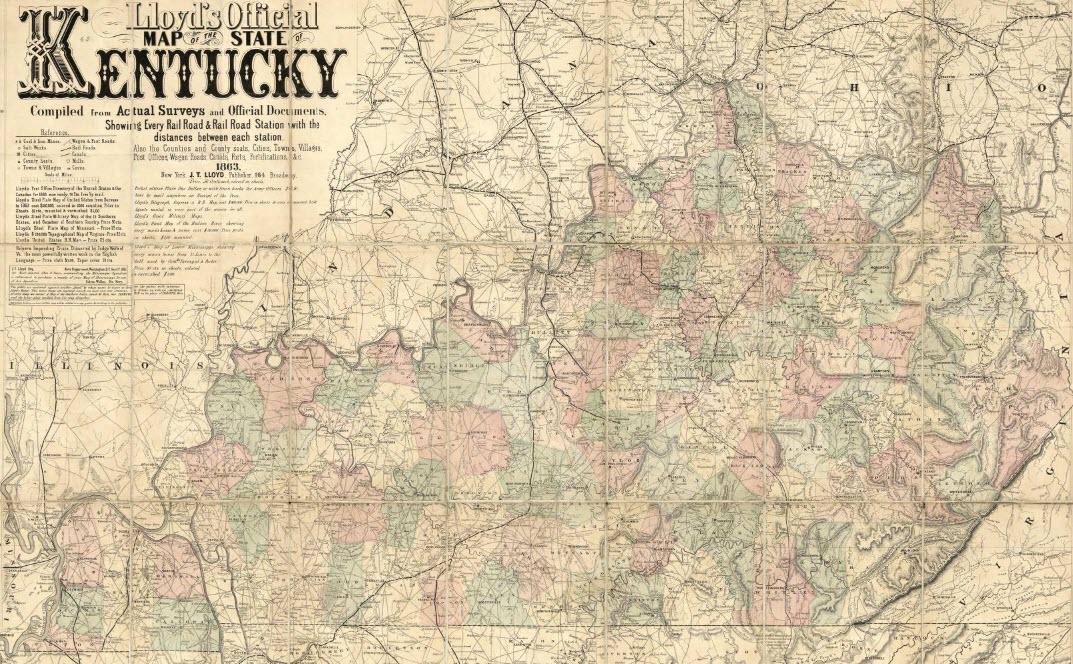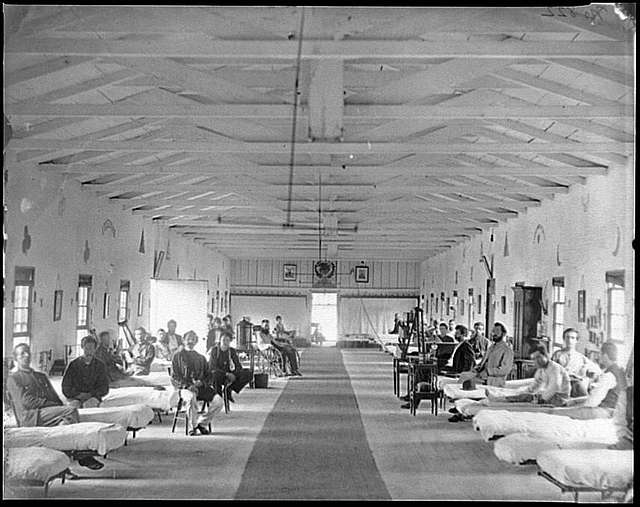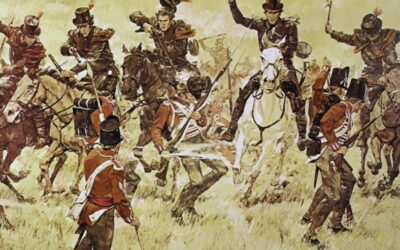Before the mighty railroads transformed the landscape of central Kentucky, the city of Lexington relied on slower and less reliable transportation methods to connect with the rest of the nation. Stagecoaches and wagons carried goods and travelers, but their limitations hindered the city’s economic growth and influence. In this enlightening blog post, esteemed railroad historian Charles H. Bogart delves into the fascinating period before the arrival of railroads in Fayette County. Join us as we explore the challenges faced, the solutions proposed, and the profound impact that railroads eventually had on the development of this vibrant region.
Lack of Cheap Transportation was the Issue
The first half of the nineteenth century found Lexington suffering a decline in influence in state policy making as its population base failed to grow at the same rate as cities based on the rivers of Kentucky. While Lexington was centrally located, it suffered from the lack of a cheap transportation system.
The city thus stagnated as Louisville and Northern Kentucky, on the Ohio River, grew in size thanks to cheap transportation of goods via the river. With the coming of the steamboat, these river cities enjoyed a renewed burst of growth. While the Kentucky River came within 20 miles of Lexington, the river’s location in a deep valley with sheer cliffs cut by an occasional steeply sloping stream made its water a poor transportation artery. Lexington depended on horse-drawn wagons to move goods.
Lexington was Land-Locked
Lexington at the beginning of the 1800s shipped and received goods via two roads. Both roads were based on rivers. Extending northeast from Lexington, a 70-mile road that ended at Maysville, provided access to the Ohio River. A 25-mile road running west from Lexington provided a connection with seasonal riverboat traffic at Frankfort, on the Kentucky River. A future 60 miles of road stretching westward from Frankfort had to be covered to reach Louisville by wagon.
Rivers Improved Commerce Opportunities
River transportation at the beginning of the century was slow and followed the river current, keelboats and flatboats being the primary method of travel. The steamboat however was posed to enter upon the scene. The steamboat, by mechanical means able to overcome the current, could move 100 to 500 tons of goods at 10 miles per hour. Thus, the cost of moving goods by water as a result dropped substantially. The cost of moving goods by road however remained constant. All river towns engaged in the movement of goods by steamboat. Commercial interest in Frankfort in 1815 started construction of a steamboat.
The typical wagon pulled by four horses could move one ton of goods 12 miles on a good day. Mud, snow, ice, and rain could cut mileage to far less. Thus on the average, it took six days for a ton of goods to travel from Maysville to Lexington. Merchandise coming by road from Frankfort to Lexington took two days and that coming by road from Louisville took seven days.
They calculated goods moved 100 miles by road increased 100 percent in cost. Lexington thus found itself unable to compete with river cities in the manufacturing of finished goods because of the cost of shipping. The result was that the city became an exporter of raw products and a supply center for nearby villages and farms.
One Solution: Why Not Build a Canal?
The Kentucky River and the road leading to Frankfort were a mixed blessing. Part of the year the Kentucky was useless as a highway for transportation. The river was far too often too low or moving too swiftly in flood for navigation. It was true the Ohio River sometimes suffered the same fate as the Kentucky but not with the frequency of that river. Shippers could never be sure that goods ordered to be sent to Lexington via Frankfort and the Kentucky River would reach that shipping point in a timely fashion.
Lexington, to improve transportation, proposed that the state canalize the Kentucky River. A series of locks and dams were to be built to provide a six-foot year round pool. This would allow steamboats to reach the waters near Versailles year round. Once complete, they would build a canal on Elkhorn Creek to the Forks of the Elkhom. The canal would then follow South Elkhom to Town Branch. Here it would proceed up Town Branch to the present vicinity of Rupp Arena where a cargo basin would be located.
A canal boat could move 10 to 20 tons of goods at two miles per hour. The typical steamboat could move 200 to 500 tons of goods between Louisville and Frankfort in two days.
A Better Solution: Just Use the Land Route
Before this plan took place, the concept of vehicles moving over tracks became known to the citizens of Lexington. The cost of connecting Lexington to the Ohio River by a railroad was judged to be much cheaper than a canal. Completion of a railroad could also be accomplished quicker than building a canal. A survey of a route from Lexington to Portland (Louisville) was undertaken. The surveyors encountered two obstacles. First was reaching the west bank of the Kentucky River. The second was scaling the hills along Long’s Run at the Jefferson county line.
The engineers proposed to overcome these two obstacles by two different methods. At Frankfort the railroad would reach the west bank of the Kentucky River via an incline. The hills, guarding the eastern entrance to Louisville, would be overcome by a swing north of them.
The route thus laid out took a serpentine course from Lexington to Frankfort. At Frankfort, they would lower the cars one-by-one to the valley floor by an incline near the Frankfort Cemetery. The cars would then cross the Kentucky River via a bridge. The track would then follow Benson Valley to the high ground of the west bank of the Kentucky River at Bagdad. Here the railroad would turn northwest toward La Grange. At La Grange, the right of way would swing west along the bank of the Ohio River to Portland.
Chartering a New Railroad
On January 30, 1830, the Lexington and Ohio Railroad was chartered. Construction on the line started in October 1831. They completed the line to Frankfort on January 31, 1834, a distance of 29 miles. Difficulties in raising money and finding labor had hampered construction, as had the choice of material to build the line. Instead of laying rail on wooden ties, the builders instead laid strap iron rail on limestone sills. The theory being that limestone would not rot like wood.
Unfortunately limestone had no give to it when trains passed over it and was subject to the heaves and sinking of wet soil and frozen ground. The railroad was soon in bankruptcy and the rail line between Frankfort and Louisville was not started. The state then took over the L&O railroad, with Kentucky as a major bond holder in the railroad, and operations leased to private operators.
Volume of traffic over the railroad during these years however was not great enough to pay for fixed cost plus maintenance. While an L&O boxcar or gondola could deliver ten tons of goods from Lexington to Frankfort in a little over two hours, the population to support the shipment of the volume of goods needed to make a profit did not exist. Lexington was at certain times of the year, a shipper of large quantities of agricultural goods, but the railroad back hauled only a few cars to Lexington loaded with finished or raw products. There is unfortunately a fixed cost to the railroad in moving a rail car whether it is loaded or not.
Travel time between Lexington and Louisville for goods in 1845 was three days using a combination of railroad to Frankfort and steamboat to Louisville. Forwarding goods by wagon to Louisville from Frankfort after delivery by train, took six days.
It can truly be said that Lexington’s salvation as a city resulted from the railroad. All the cities of Central Kentucky that prospered in the period of 1850 to 1950 were on a railroad. Not that the railroad turned every village it touched into a town or every town into a city. Berry, Butler, Sadieville, Baghdad, and Burgin are proof that not all places serviced by a railroad blossomed into a commercial hub.

Lloyd’s official map of the state of Kentucky compiled from actual surveys and official documents, showing every rail road & rail road station with the distances between each station. Also the counties and county seats, cities, towns, villages, post offices, wagon roads, canals, forts fortifications. Source: Library of Congress #98688486
Main Railroads in Kentucky
Here is a quick recap of the main railroads from 1847 to 1870.
Lexington and Frankfort Railroad
In 1848, the Lexington and Frankfort Railroad was incorporated. This railroad that year took over operation of the Lexington and Ohio Railroad. To avoid lowering the freight and passenger cars down the hill by incline plane an alternative route was surveyed into Frankfort. The rail route now swung west from Jett and down Vaughn Branch to the Kentucky River. The tracks then followed the east bank of the river to Frankfort. Entrance to Frankfort was through a 300-foot tunnel bored under the State Arsenal. In February 1850, the train service was available from Broadway and Vine in Lexington to St. Clair and Broadway in Frankfort.
Louisville and Frankfort Railroad
The year 1847 had seen the incorporation of the Louisville and Frankfort Railroad. This railroad proposed to build from Louisville to Frankfort over the never built Lexington and Ohio line west of Frankfort. This line was completed to Frankfort on September 8, 1851; though train service between Lexington and Louisville began some time later that year. Records however show that at first horse and not steam engines were used to haul cars across the river. Travel time between the two, Louisville and Lexington, by rail in 1860 was six and half hours.
Steam powered trains began crossing the Kentucky River at Frankfort in 1863, after the bridge over it was rebuilt by Union troops, following its destruction by Kirby Smith’s army. It is possible however that there were steam powered trains between the two cities before this date. Travel time between the two cities in 1868 was five hours. In a period of approximately 70 years, they reduced travel time to move a ton of merchandise between Lexington and Louisville from seven days to five hours.
Kentucky Central Railroad
The Kentucky Central Railroad would also connect with Covington, Kentucky, across the Ohio River from Cincinnati in 1856. In time, Lexington, because of perceived rate discrimination on rail shipments between Louisville and Lexington, would turn toward Cincinnati. This, looking toward Cincinnati as an ally, gained impetus as Louisville extended its rail system south and east of Lexington.
Louisville Nashville Railroad
The Louisville and Nashville Railroad sought to gain control of the Kentucky Central Railroad and its track between Cincinnati and Lexington. Thus, when Cincinnati in 1870 proposed to build a railroad south from Cincinnati to Chattanooga, the Cincinnati Southern, Lexington joined with the Queen City to build this railroad. Lexington saw the Cincinnati Southern to regain commercial ascendancy over the towns and villages to the south and east of Fayette County.





